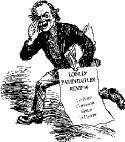
 |
 |

| Thursday, April 25, 2024 |
Miles from the Mainstream |
D.
R. ZUKERMAN, proprietor |
LPR Calls for a Study on the Curious Practice of Imagined Political Journalism
September 5, 2017 -- The lead editorial in The New York Times, November 6, 2016 – two days before Election Day – was titled “Imagining the Country on Nov. 9.” The editorial imagined that, if elected, Donald J. Trump would be “an ignorant and reckless tyrant….” The New York Times, however, as the nation moves into the eighth month of the Trump presidency has not been shut down by a tyrant in the White House, nor has any media outlet been closed down on orders of a tyrannical Trump. Reports in The Wall Street Journal mention continued IRS harassment of conservative groups, and leftist violence against conservative groups. There is also a report about a 6 a.m. F.B.I. raid on the home of former Trump campaign manager Paul Manafort. To the knowledge of LPR, none of these events have drawn criticism from the media at large – certainly not from The New York Times, which uses its lurid political imagination, not objective reporting, to present two main political themes: President Trump is sympathetic to nasty groups on the right and his presidency will split the Republican Party, leading to disaster for the GOP in the 2018 congressional elections. At least as early as March 1, 2016 – five and a half months before Charlottesville -- The New York Times imagined that a certain bond may exist between Donald J. Trump and “white supremacists.” An article by Jonathan Mahler carried this headline: “Trump’s Message Resonates With White Supremacists.” Highlighted amid the text was this assertion: “Intentionally or not, a candidate mobilizes a group that normally stays out of politics.” By the time of the November 6, 2016 editorial, the Times extended to “the Republican establishment” its imagination that this establishment moved “in lock step now with [among others] the alt-right, the Ku Klux Klan, the racists and misogynists and nut jobs….” Media coverage of the events in Charlottesville, led by The New York Times, are, therefore consistent with the imaginary narrative that the management of The New York Times months ago determined, LPR believes, harp on – Big Lie-style – to terminate the Trump presidency. Why? In Frank Capra’s “Meet John Doe,” Doe, in a nationwide radio talk, delivers a populist statement that includes this comment: “And when a copy yells: ‘Stand back there, you!’ He means us, the John Does.” | When a snooty columnist like David Brooks writes about feeling uncomfortable with people, “ He means us, the John Does.” To put it this way, you are not likely to find the people demonizing President Trump being ordered; “Stand back there, you!” Yet they, LPR strongly believes, are precisely the people Madison had in mind when he warned us about those seeking the “ambitious sacrifice of the many to the aggrandizement of the few.” Yes, LPR has a hunch that the major source of political hatred, today, comes from the insiders who hate the thought that their privileged access to wealth and power might be under challenge via a Trump presidency. Consider the following from The New York Times, January 10, 2016: “Rank-and-file conservatives after decades of deferring to party elites are trying to stage what is effectively a people’s coup by selecting a standard-bearer who is nt the preferred candidate of wealthy donors and elected officials.” What is The New York Time saying -- that the proper role of ordinary people in a constitutional republic is to defer to a candidate chosen by insiders – and live on the few crumbs distributed to them? LPR believes a study should be made of Trump coverage by The New York Times from the announcement of his presidential candidacy, through the election and on past the events in Charlottesville, Virginia, August 12, 2017. This study should take note of the number of editorials published on Trump by the Times, the regular op-ed columns on Trump, columns on Trump by outsiders. The study should also analyze the pattern, if any, suggested from the letters to the editor published in the Times on Trump. The study should estimate the cost to the Times of publishing these editorials, columns and letter. The study should conclude with an assessment as to whether the imaginary journalism practiced at The New York Times is consistent with the spirit of the free and honest flow of information in a nation founded on the principle of a free and vigorous press.  |
|
